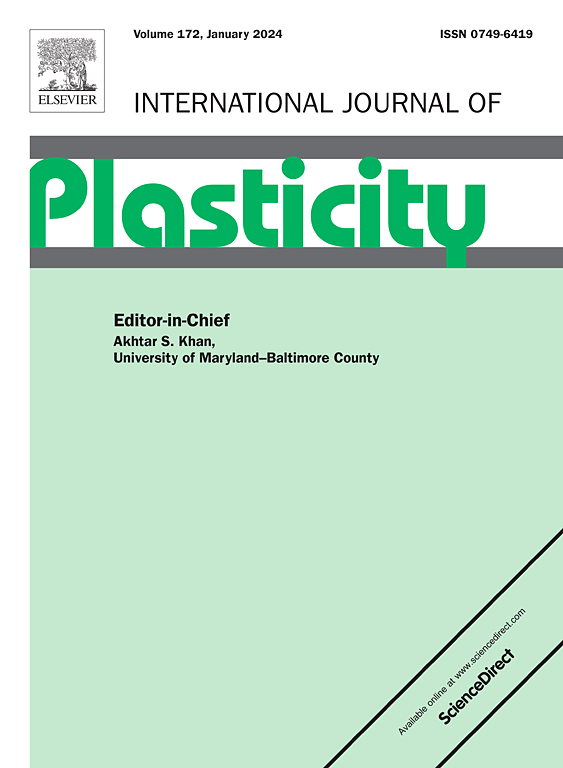Creep deformation of unidirectional metal matrix composites: modeling and experimental observations
IF 12.8
1区 材料科学
Q1 ENGINEERING, MECHANICAL
引用次数: 0
Abstract
The creep response of elastic fiber-reinforced metal matrix composites is modeled by establishing governing equations that link the composite's behavior under creep tests to that of the unreinforced creeping matrix in the stress relaxation test. These findings diverge from widely accepted models, which are well-acknowledged on the priori assumption of extending the steady-state creep method from constant stress to decreasing stress conditions. The unreachability of the steady-state creep of the creeping matrix with elastic reinforcements is demonstrated, as continuous stress transfer occurs from the creeping matrix to the elastic fibers. Experimental validation through stress relaxation tests reveals significant discrepancies, including underestimation in the short term and overestimation in the long term, driven by altered stress evolution paths for the creeping matrix. In this work, the relationships of governing equations among stress relaxation tests of unreinforced matrices, creep tests of composites and stress relaxation tests of composites are established, emphasizing the condition of the creeping matrix under decreasing stress. The difference in the effect of broken fibers on the strain increase between localized strain within the stress recovery distance and averaged strain over the extensometer gauge length is discussed. An experimental validation method is proposed and conducted by examining the elastic modulus variation of the composite in the loading and unloading stages during repeated creep tests.


单向金属基复合材料的蠕变:模型和实验观察
通过建立连接弹性纤维增强金属基复合材料蠕变试验行为和未增强金属基复合材料应力松弛试验行为的控制方程,模拟了弹性纤维增强金属基复合材料的蠕变响应。这些发现与广泛接受的模型不同,这些模型在将稳态蠕变方法从恒定应力扩展到减小应力条件的先验假设上得到了很好的认可。由于应力从蠕变基体向弹性纤维的连续传递,证明了弹性增强的蠕变基体稳态蠕变的不可达性。通过应力松弛试验的实验验证揭示了显著的差异,包括短期的低估和长期的高估,这是由蠕变矩阵的应力演化路径改变所驱动的。本文建立了未加筋基体应力松弛试验、复合材料蠕变试验和复合材料应力松弛试验之间的控制方程关系,强调了蠕变基体在减小应力作用下的条件。讨论了断裂纤维在应力恢复距离内的局部应变和在延伸计长度上的平均应变对应变增加的影响的差异。通过反复蠕变试验,研究复合材料在加载和卸载阶段的弹性模量变化,提出了一种试验验证方法。
本文章由计算机程序翻译,如有差异,请以英文原文为准。
求助全文
约1分钟内获得全文
求助全文
来源期刊

International Journal of Plasticity
工程技术-材料科学:综合
CiteScore
15.30
自引率
26.50%
发文量
256
审稿时长
46 days
期刊介绍:
International Journal of Plasticity aims to present original research encompassing all facets of plastic deformation, damage, and fracture behavior in both isotropic and anisotropic solids. This includes exploring the thermodynamics of plasticity and fracture, continuum theory, and macroscopic as well as microscopic phenomena.
Topics of interest span the plastic behavior of single crystals and polycrystalline metals, ceramics, rocks, soils, composites, nanocrystalline and microelectronics materials, shape memory alloys, ferroelectric ceramics, thin films, and polymers. Additionally, the journal covers plasticity aspects of failure and fracture mechanics. Contributions involving significant experimental, numerical, or theoretical advancements that enhance the understanding of the plastic behavior of solids are particularly valued. Papers addressing the modeling of finite nonlinear elastic deformation, bearing similarities to the modeling of plastic deformation, are also welcomed.
 求助内容:
求助内容: 应助结果提醒方式:
应助结果提醒方式:


